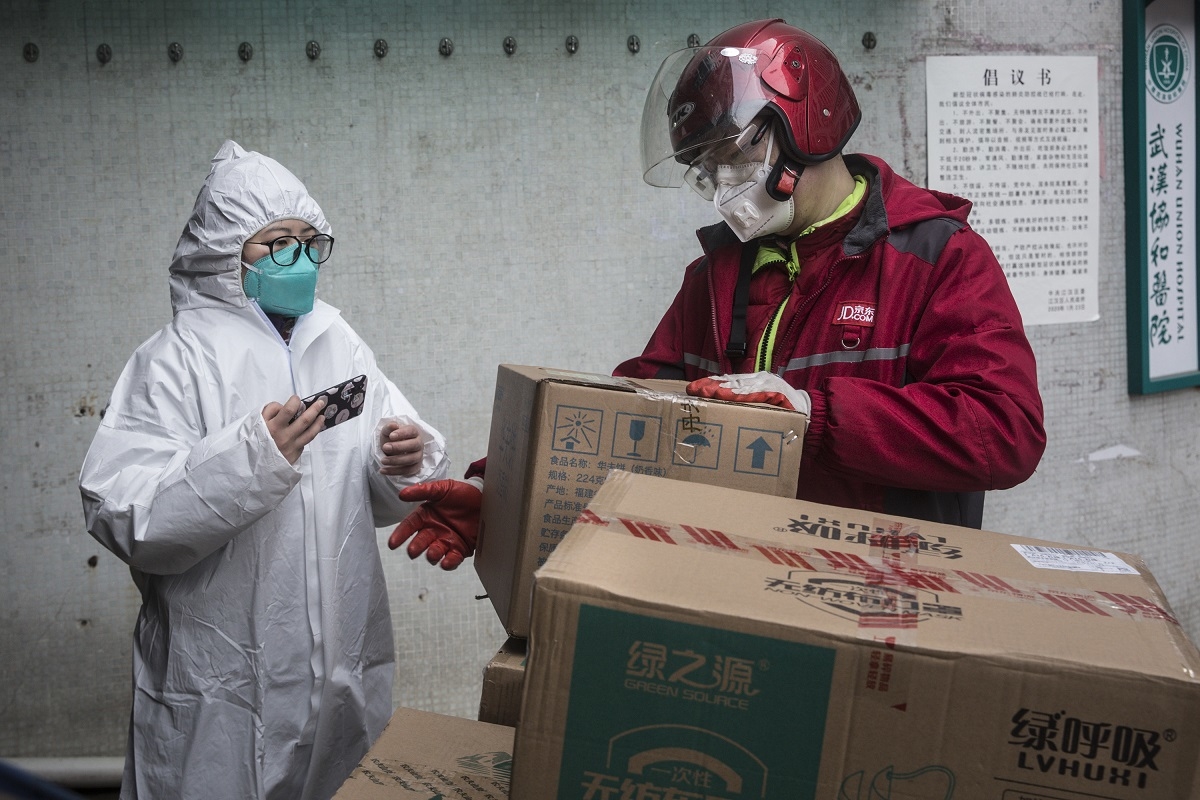As the novel coronavirus disease (COVID-19) epidemic continues in China, so do the efforts of civil society organizations (CSOs) and concerned citizens to mitigate the harm. In the official approach to managing their involvement, there have been clumsy force-of-habit measures from the state, controversies over how donations are collected and deployed, and punishments for cadres-cum-charity leaders. Early government attempts to monopolize the collection and deployment of donated money and materials have caused critical bottlenecks, and weak coordination among departments and policies are blocking efficient deployment of desperately needed protective equipment. But scholars, donors, CSO professionals, and volunteers are constantly probing for ways around constraints. They have acted swiftly to question government measures, produce policy recommendations, trace and challenge the deployment of protective masks and other vital resources by officially-backed charities, and organize teams able to deliver goods directly to hospitals. As this surge of social activity draws attention to the problems created by initial government measures, the Ministry of Civil Affairs is now shifting its policy toward facilitating rather than frustrating CSO efforts, including those of foundations and government-organized NGOs (GONGOs).
Early Constraints
On January 23, the day the government announced Wuhan was to be cordoned off to prevent the further spread of the coronavirus, the official Wuhan City COVID-19 Command Center (武汉市新冠肺炎疫情防控指挥部), a local government body set up to coordinate control efforts, issued a notice calling for charitable donations. The notice designated two GONGOs as official recipients of both cash and material donations: the Wuhan Red Cross and the Wuhan Charity Federation. It also announced that the Command Center itself would be in charge of “unified allocation and use.” That is, these two GONGOs would receive donations, and the Command Center would control their deployment.
Three days later, the Hubei COVID-19 Command Center (the provincial-level equivalent to the Wuhan Command Center) issued a similar notice. It designated three provincial-level GONGOs as donation recipients (the Hubei Red Cross, the Hubei Charity Federation, and the Hubei Youth Development Foundation) and named itself as the entity in charge of deploying those donations. That same day, the Ministry of Civil Affairs (MOCA) issued Public Notice No. 476, reiterating the requirement that donations be funnelled through these five GONGOs and that they be deployed by local command centers. The responses to these measures were mixed. On one hand, donations were high. Between midnight on January 23 and 4:00 p.m. on January 25, the Hubei Red Cross said it had received almost 6.5 million renminbi in funds and materials. Between the 25th and 26th, that figure shot up to almost 35 million, and by the 27th it exceeded 2.1 hundred million renminbi. At the same time, however, CSO leaders, experts, and scholars expressed serious concerns about the implications of the government’s limit on the number of CSOs able to collect donations, as well as the government’s own role in commandeering deployment.
Concentrated Command and Controversy
In the context of public emergencies, there is plenty of precedent for the Chinese government to require that public donations be made to government or GONGO bank accounts. During the SARS outbreak in 2003, for example, MOCA ordered that all donations be made to its own departments, government health bureaus, the national Red Cross, or the China Charity Federation. At the time this was not surprising, since China did not yet have clear measures allowing independent CSOs to solicit donations from the public. But in 2004, watershed regulations permitted some independent foundations to engage in public fundraising. After the Wenchuan earthquake in 2008, foundations did just that, though the government later took measures to rein this in by retroactively issuing approval for a select few, thereby essentially designating 16 recipient foundations. When the Ya’an earthquake hit in 2013, the government adopted a very different approach, no longer designating organizations to monopolize donations or commandeering deployment. Then, in 2016, the Charity Law opened public fundraising further to other kinds of CSOs, or at least to those that could jump through enough hoops.
Yet despite the existence in late January 2020 of the over 1,823 charitable organizations then accredited as fundraisers under this legislation, authorities chose to designate only five charities as official recipients of public donations for the coronavirus. Most importantly, they concentrated power over deployment in the hands of the government-run command centers.
In the days that followed these notices, the designated GONGOs struggled to cope with the outpouring of public support. The Hubei Red Cross is not a vast organization. Without knowing exact staff numbers, we can estimate its size from its 2019 annual report, which budgeted just over 2 million renminbi (less than U.S.$300,000) for basic staff wages. Even with a system of organizations operating under it, logistically it was likely overwhelmed by the sheer volume of donations of funds and donated materials and the logistical challenges of deploying them. Only three days after being designated a recipient in the January 26 notice, the Hubei Red Cross was already being questioned by netizens over its deployment of N95 masks. It quickly apologized for incorrect reporting on the type and number of masks delivered, as if its deployment had been trouble-free but some careless staff member had typed “N95” instead of “KN95” when writing up their report. The provincial discipline and supervisory commissions stepped in to show they were holding someone to account: They sacked the vice-director of the Hubei Red Cross, removed him from its Party group, and used Party disciplinary measures to reprimand two other leaders. They made no mention of the organization’s director, who is also deputy governor of Hubei province. These “accountability” measures fell short of addressing the key issue: that the power to deploy donations was, according to the government notices, meant to rest not with the Red Cross but with the Hubei Command Center.
Who can collect donations is important, but the crux of the problem is who can deploy them. Throughout this epidemic, Chinese scholars have argued that CSOs shouldn’t exist merely as extra-legal tax collectors, soliciting money and then turning it over to the government. They should be encouraged and assisted, or at least permitted, to use the donations they collect. CSOs and ad hoc groups of concerned citizens have been constantly attempting to do just this, despite the early state measures designed to discourage it.
A Caveat and CSO Ingenuity
Though state measures may have been ill-conceived, there was a caveat in the central public notice that designated the five GONGOs and put government command centers in charge of deployment. MOCA’s Notice No. 476 contained the phrase: “with the exception of earmarked donations” (除定向捐赠外). If donations were “earmarked” for a specific purpose, the document stipulated, command centers could not lay claim to them.
One example of the many CSOs that have thus been able to circumvent the GONGO middlemen and preserve some independence from the command centers is the Han Hong Love Charity Foundation (韩红爱心慈善基金会). By establishing a project specifically with the purpose of purchasing and distributing medical resources to Wuhan and the surrounding cities, it sidestepped the requirement to hand funds over for “unified allocation” as per the government notices. The foundation did announce on January 27 that to “actively respond to the state’s urgent emergency aid policy on unified allocation of medical resources” it had donated 3 million renminbi of its funds to the Wuhan Red Cross. But while this gesture showed that the foundation was not ignoring state calls, the 3-million-renminbi donation to the state-designated GONGO was only a fraction of the amount that people—actors, musicians, and other concerned citizens—were donating to the Han Hong Love Charity foundation. By January 31, it had received 1.4 hundred million renminbi. The scale of donations was such that it threatened to overwhelm the foundation’s capacity to translate funds into deliveries of medical materials. By February 1, the foundation halted fundraising, issuing a statement asking that no more donations be made to its bank accounts. As of March 1, the foundation was still purchasing and delivering medical materials and posting frequent updates on its Weibo platform and WeChat public account. Efficient as this one foundation may be, its inability to handle any more donations illustrates the need to involve more CSOs in the epidemic response.
Smaller, less high-profile CSOs also able to skirt the middlemen have been similarly overwhelmed. Based in Hefei, a CSO registered under the Anhui Civil Affairs Bureau as a citizen-run non-profit organization (民办非企业单位) has been getting protective gear to hospitals while navigating obstacles like changing local policies that restrict the transport of medical and other goods. After successfully managing to purchase and deliver several earlier batches, it hit problems when attempting to deliver protective gowns to hospitals and decided to request permission from a group of WeChat donors to redirect their donations for use elsewhere.
Finally Relaxing the Rules
Nineteen days after Notice No. 476, MOCA released a new set of guidelines. This newer policy document places charities on an equal footing with the Red Cross chapters, signalling a shift toward emphasizing their role in the epidemic response. As if giving the nod to what CSOs have already been doing, unlike the original notice and its tucked-away caveat, the newer policy actively encourages CSOs to use earmarked funds. Using clear, straightforward, and unambiguous language, Article 7 states that “earmarked donations received by charities . . . may be delivered to the final users according to donors’ wishes.” It allows also for non-earmarked donations to be delivered directly to their final destination, meaning that even if donors haven’t expressed the wish that their donations be “earmarked,” if the CSO has the capacity to deliver directly without handing donations over to a third party, MOCA supports them in doing so. Local authorities might have their own policies that conflict with this relaxation, but the civil affairs system appears to be attempting to facilitate, not frustrate, civil society participation. In the days and weeks ahead, the demand for myriad CSOs to participate and apply their expertise will be great. Enabling, rather than constraining, this participation would be a crucial step by the government to help its citizens help one another and to mitigate the harm of the epidemic going forward.

